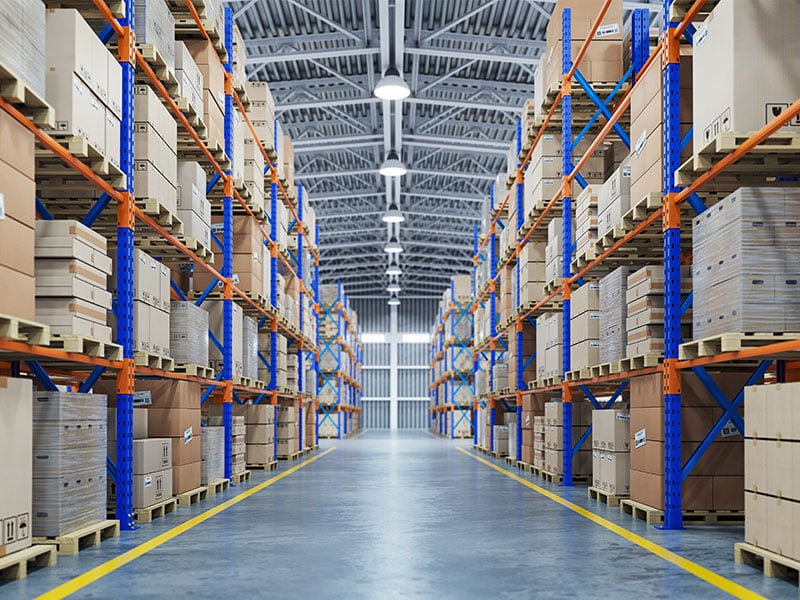Warehousing is the process of storing physical inventory for sale or distribution. Warehouses are used by all different types of businesses that need to temporarily store products in bulk before either shipping them to other locations or individually to end consumers.
For instance, many ecommerce businesses will purchase products in bulk from their suppliers, who ship them to their warehouse for storage. When an end customer then places an order from the ecommerce site, the business — or its third-party fulfillment provider — picks and packs the product from the warehouse and ships it directly to the customer.
Ecommerce has driven rapid growth throughout the warehousing industry. In fact, the market has doubled in the last decade as businesses around the world invest heavily in their supply chains to get goods to consumers and businesses faster and more efficiently.
This isn’t only limited to ecommerce businesses. Most physical retail businesses have limited space in their stores to hold inventory but still need to keep up with demand. Having additional inventory available in nearby warehouses helps ensure they are always able to restock their stores during high volume times like the holidays, even if their suppliers are in other countries and are slow to produce and ship new product.
Warehouse vs. distribution center
While a warehouse is technically any building that stores physical products regardless of the purpose, a distribution center is more specifically a type of warehouse designed for fulfilling orders for the purpose of distribution to other businesses or consumers. Distribution centers, therefore, need to be designed for not only compact storage but also efficient picking, packing, and shipping.
Why is warehousing important?
Warehousing is an essential part of the supply chain for most types of businesses that deal in physical goods. This could be consumer businesses holding a product that eventually makes its way to an end retail customer, or it could be business to business (B2B) companies storing products that eventually make it to business customers.
For retail and ecommerce businesses, warehousing allows the purchase of wholesale goods in bulk that may not fit in a physical retail store or yet be purchased by an end consumer online. Large bulk orders allow these businesses to negotiate lower prices with their suppliers, thus improving their margins when selling to customers. They can also keep inventory available as demand fluctuates to ensure products stay in stock.
In addition, warehousing allows businesses to store products in strategic geographic areas to reduce delivery times and shipping costs. For example, if a business is selling a product directly to consumers across the US, they may want to store inventory in multiple different regions of the country. Similarly, if they’re selling to consumers around the globe, they’ll want to strategically place warehouses in different countries to speed up deliveries and minimize shipments that have to go through customs.
With over 20,000 warehouses around the US and consumers now very accustomed to same-day delivery, this is becoming an ever more important aspect of businesses shipping directly to customers.
The elements of warehousing
While warehousing may seem simple since it mainly involves leaving products in storage, there are a number of processes involved to ensure it’s done efficiently and inventory can be moved in and out quickly, including:
- Capacity planning
Space is the key resource. Therefore, when a shipment of products is expected, staff need to plan for where the products are going to be stored to make the most efficient use of the space. - Receiving inbound shipments
When products arrive at the warehouse, staff will need to receive the items and carefully move them to a staging area for processing. - Tracking inventory
As items flow in and out of the warehouse, they need to be registered in the warehouse inventory management system to ensure administrators can track what’s currently in inventory and plan for future changes. - Storing products
After products have been received and processed, they need to be stored. This can involve putting the products in bins and pallets and then using moving equipment to transport them to their appropriate storage space. - Controlling climate
Depending on the nature of the products, factors like temperature, humidity, or pressure may need to be kept constant. For example, frozen goods will need to be stored in areas where the temperature is below freezing. These requirements will affect how and where products are stored within the facilities to ensure proper quality. - Reorganizing
As new products are brought in, existing inventory may need to be moved to make sure the whole space is being most efficiently utilized. Any changes need to be tracked and updated in the inventory management systems. - Retrieving and outbound shipping
Finally, when products need to go out of the warehouse for shipment, staff needs to retrieve, process, package, load them, and then release them from inventory to allow space for new inbound products.
Warehousing and the supply chain
Warehousing is an integral piece of the broader supply chain for physical products. Warehouses do not only serve as intermediary storage facilities — they also provide the ability for supply chain managers to reduce costs by optimizing inventory purchases, saving shipping costs and speeding up delivery times.
Warehousing even permits things like repackaging products for marketing purposes or to optimize the package for last mile delivery. These are important steps in ensuring products get through the supply chain to the end customer, ensuring they have the best possible experience with your company.
